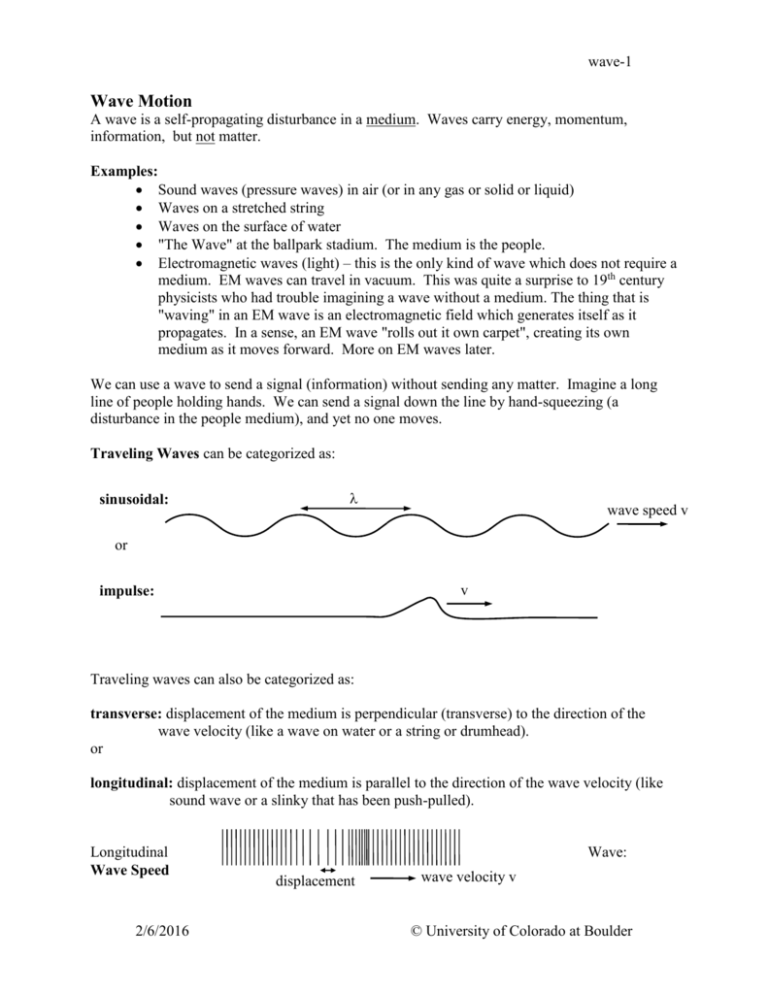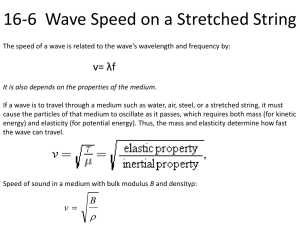Wave Motion - University of Colorado Boulder
advertisement

wave-1 Wave Motion A wave is a self-propagating disturbance in a medium. Waves carry energy, momentum, information, but not matter. Examples: Sound waves (pressure waves) in air (or in any gas or solid or liquid) Waves on a stretched string Waves on the surface of water "The Wave" at the ballpark stadium. The medium is the people. Electromagnetic waves (light) – this is the only kind of wave which does not require a medium. EM waves can travel in vacuum. This was quite a surprise to 19th century physicists who had trouble imagining a wave without a medium. The thing that is "waving" in an EM wave is an electromagnetic field which generates itself as it propagates. In a sense, an EM wave "rolls out it own carpet", creating its own medium as it moves forward. More on EM waves later. We can use a wave to send a signal (information) without sending any matter. Imagine a long line of people holding hands. We can send a signal down the line by hand-squeezing (a disturbance in the people medium), and yet no one moves. Traveling Waves can be categorized as: sinusoidal: wave speed v or v impulse: Traveling waves can also be categorized as: transverse: displacement of the medium is perpendicular (transverse) to the direction of the wave velocity (like a wave on water or a string or drumhead). or longitudinal: displacement of the medium is parallel to the direction of the wave velocity (like sound wave or a slinky that has been push-pulled). Longitudinal Wave Speed 2/6/2016 Wave: displacement wave velocity v © University of Colorado at Boulder wave-2 For a sinusoidal wave, wave speed is distance 1 wavelength v = = = time time for 1 l to go by v = l = l f T l T , T = period ( since frequency f = 1/T ) Almost always, the wave speed v is a constant, independent of and T. The wave speed v depends on the properties of the medium, not on the properties of the wave. Examples: medium = string, properties = tension, mass per length medium = air, properties = temperature, mass per molecule, etc em waves in vacuum: wavespeed = speed of light = fixed. v = f = constant increases as f decreases, decreases as f increases Mathematical description of traveling sinusoidal waves Sinusoidal waves have a wavelength and a frequency f = 1/T . (Impulse waves have neither.) y y = y (x, t) v x y = displacement y = displacement from the equilibrium (no wave) position Snapshot in time: freeze time at, say, t = 0 y æ xö y(x, t = 0) = A sin çç2p ÷ ÷ çè l ÷ ø +A x –A = A sin (k x ) A is the amplitude of the wave. The displacement oscillates between +A and –A. 2p k= = wave number l Now freeze position, watch wave go by at position x = 0: 2/6/2016 © University of Colorado at Boulder wave-3 y æ tö y(x = 0, t) = A sin çç2p ÷ ÷ çè T ÷ ø +A = A sin (w t ) t –A w= 2p = angular frequency T Wave traveling to the right: é æx t öù y(x, t) = A sin ê2p çç - ÷ ÷ú = A sin (k x - w t ) êë çèl T ÷ øú û Notice: When position x changes by distance or time t changes by period T, the sine function goes through one complete cycle. When x increases by one AND t increases by one T, then the sine function stays at the same phase; we are then riding along with the wave. y +A x –A The argument of the sin function (kx - wt ) is called the phase. A point on the traveling wave (traveling along with the wave) corresponds to a particular value of the phase (kx - wt ). As t increases, x must increase in order to keep (kx - wt ) a constant value, hence a point of constant phase corresponds to a point moving to the right (increasing x). Could also have a wave traveling to the left: é æx t öù ú y(x, t) = A sin ê2p çç + ÷ ÷ ÷ú êë èçl Tø û We could have used cosine instead of sine for the form of the wave. The only difference between sin and cos here is where we put the zero of time. In general, you can have anything in between sine and cosine: y(x, t) = Asin (k x - wt + j ) . The phase constant is set by the zero of time. Wave speed is v = v = distance = time 1 wavelength = time for 1 l to go by l T l w = l f = T k Another way to see that our formula for the wave y = y(x,t) corresponds to a wave moving right with speed v =/T is to rewrite the formula like so: 2/6/2016 © University of Colorado at Boulder wave-4 é æx t öù é2p æ l öù é2p ù ú = A sin ê ççx - t ÷ ú = A sin ê (x - v t )ú y(x, t) = A sin ê2p çç - ÷ ÷ ÷ ÷ ÷ ç ç êë èl T øú êë l è êë l ú T øú û û û A point traveling with the wave is a point with (x – v t) = constant or x = vt + const. This is the equation for a point moving right with speed v (graph of x vs t has slope x/t = v) . Claim: Any traveling wave y = y(x,t), traveling with a rigid shape ("dispersionless") has the form y(x, t) = f (x - v t) (wave traveling to right with speed v) or y(x, t) = f (x + v t) (wave traveling to left with speed v) Proof: Consider a wave initially with some shape y = f(x) (at t = 0 ) y that is moving to the right with speed v. x And consider a moving coordinate system (x', y') , that is moving along with the wave y y' x0 = v t Coordinate transform: x = x' + v t , x' = x – v t y = y' f(x, t=0) v f(x, t1>0) x y'= f(x') v x' x y x vt y' x' (x, y) = (x', y') x x' In the moving x'y' coordinate system, the moving wave is stationary: y' = f(x'). Transfoming to the xy coordinate system, the wave y' = f(x') becomes y = f(x – v t). Done. Interference of waves Superposition Principle: If two or more waves are present in the same place, at the same time, the total wave is the sum of the individual waves: ytot(x,t) = y1(x,t) + y2(x,t). You get constructive or destructive interference depending on whether y1 and y2 add (both have same sign) or cancel (opposite signs). 2/6/2016 © University of Colorado at Boulder wave-5 v time 1) v time 2) time 3) time 4) Waves carry energy. For a string wave, the energy is both KE (string moves as wave passes) and PE (originally straight string must stretch a little as wave passes – elastic PE similar to (1/2)kx2 ). At time 3 above, where is the energy? Answer: in the KE. At time 3, the string is moving, while instantaneously flat. Standing Waves Two sinusoidal traveling waves of the same (and therefore the same f = v/ ) and the same amplitude, traveling in opposite directions, overlapping in the same region of space, make a standing wave. L ends fixed x m nodes anti-nodes If the ends of a string of length L are fixed, as in a stringed musical instrument, then standing waves are only possible at certain resonant frequencies given by the condition: L n , n = integer, L = fixed total length 2 2/6/2016 © University of Colorado at Boulder





